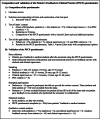Let's ask the patient - composition and validation of a questionnaire for patients' feedback to medical students
- PMID: 33971866
- PMCID: PMC8111976
- DOI: 10.1186/s12909-021-02683-y
Let's ask the patient - composition and validation of a questionnaire for patients' feedback to medical students
Abstract
Background: Adequate communication and maintaining a patient-centered approach throughout patient encounters are important skills for medical students to develop. Feedback is often provided by clinical teachers. Patients are seldom asked to provide feedback to students that systematically addresses knowledge and skills regarding communication and patient-centeredness during an encounter. One way for patients to provide feedback to students is through a questionnaire; there is, however, a lack of such validated feedback questionnaires. This study aimed to compose and validate a feedback questionnaire for patients' feedback to medical students regarding students' ability to communicate and apply patient-centeredness in clinical practice.
Method: This study comprises (a) composition of the questionnaire and (b) validation of the questionnaire. The composition included (1) literature review, (2) selection and composition of items and construction of an item pool, (3) test of items' content, and (4) test of the applicability of the questionnaire. The items originated from the Calgary-Cambridge Guide (Kurtz S, Silverman J, Benson J and Draper J, Acad Med 78:802-809, 2003), the 'Swedish National Patient Survey' (National Patient Survey, Primary Health Care, 2020), patient evaluation form by Braend et al. (Tidsskr Nor Laegeforen 126:2122-5, 2006), and additional developed items. The items were further developed after feedback from 65 patients, 22 students, eight clinical supervisors, and six clinical teachers. The validation process included 246 patients who provided feedback to 80 students. Qualitative content analysis and psychometric methods were used and exploratory factor analysis assessed internal validity. Cronbach's alpha was used to test the reliability of the items.
Results: The process resulted in the 19-item 'Patient Feedback in Clinical Practice' (PFCP) questionnaire. Construct validity revealed two dimensions: consultational approach and transfer of information. Internal consistency was high. Thematic analysis resulted in three themes: ability to capture the personal agenda of the consultation, alignment with the consultation, and constructs and characteristics. Students reported that the PFCP questionnaire provided useful feedback that could facilitate their learning in clinical practice.
Conclusions: The results of this study indicate that the questionnaire is a valid, reliable, and internally consistent instrument for patients' feedback to medical students. The participants found the questionnaire to be useful for the provision of feedback in clinical practice. However, further studies are required regarding the PFCP questionnaire applicability as a feedback tool in workplace learning.
Keywords: Clinical practice; Communication; Composition of questionnaire; Medical students; Patient feedback; Patient-centered; Questionnaire validation; Survey; Work-based learning.
Conflict of interest statement
The authors report no conflicts of interest in this study.
Figures
Similar articles
-
Multisource feedback in medical students' workplace learning in primary health care.BMC Med Educ. 2022 May 25;22(1):401. doi: 10.1186/s12909-022-03468-7. BMC Med Educ. 2022. PMID: 35614484 Free PMC article.
-
Development of an instrument to measure medical students' perceptions of the assessment environment: initial validation.Med Educ Online. 2015 Oct 27;20:28612. doi: 10.3402/meo.v20.28612. eCollection 2015. Med Educ Online. 2015. PMID: 26511792 Free PMC article.
-
Adaptation and validation of the instrument Clinical Learning Environment and Supervision for medical students in primary health care.BMC Med Educ. 2016 Dec 1;16(1):308. doi: 10.1186/s12909-016-0809-8. BMC Med Educ. 2016. PMID: 27905932 Free PMC article.
-
[Psychometric characteristics of questionnaires designed to assess the knowledge, perceptions and practices of health care professionals with regards to alcoholic patients].Encephale. 2004 Sep-Oct;30(5):437-46. doi: 10.1016/s0013-7006(04)95458-9. Encephale. 2004. PMID: 15627048 Review. French.
-
Contribution of students to nursing practice settings during clinical training: Design and validation of a questionnaire.J Adv Nurs. 2021 Sep;77(9):3940-3951. doi: 10.1111/jan.14891. Epub 2021 May 18. J Adv Nurs. 2021. PMID: 34002869 Review.
Cited by
-
Redefining medical education: harnessing the power of patient feedback.Front Med (Lausanne). 2024 Oct 18;11:1453262. doi: 10.3389/fmed.2024.1453262. eCollection 2024. Front Med (Lausanne). 2024. PMID: 39493716 Free PMC article. No abstract available.
-
Multisource feedback in medical students' workplace learning in primary health care.BMC Med Educ. 2022 May 25;22(1):401. doi: 10.1186/s12909-022-03468-7. BMC Med Educ. 2022. PMID: 35614484 Free PMC article.
-
Learning from patients' written feedback: medical students' experiences.Int J Med Educ. 2022 Jan 31;13:19-27. doi: 10.5116/ijme.61d5.8706. Int J Med Educ. 2022. PMID: 35108219 Free PMC article.
-
Ask the Parent: Developing a Pediatric Feedback Form for Medical Learners.J Med Educ Curric Dev. 2025 Mar 13;12:23821205251327375. doi: 10.1177/23821205251327375. eCollection 2025 Jan-Dec. J Med Educ Curric Dev. 2025. PMID: 40092406 Free PMC article.
-
Patients as Feedback Providers: Exploring Medical Students' Credibility Judgments.Perspect Med Educ. 2023 Apr 12;12(1):129-140. doi: 10.5334/pme.842. eCollection 2023. Perspect Med Educ. 2023. PMID: 37064270 Free PMC article.
References
-
- Ministry of Health and Social Affairs. In: Goverment S, editor. The Patient Act: Government Offices of Sweden: Ministry of Health and Social Affairs; 2015. http://www.regeringen.se/contentassets/b1a9ef9b43e9468f9345fcdbe8c60fe9/.... Accessed 19 Aug 2016.
-
- The Swedish Agency for Health and Care Services Analysis. The health care from the patients' perspective - comparisons between Sweden and 10 other countries. Stockholm: The Swedish Agency for Health and Care Services Analysis; 2016. https://www.vardanalys.se/rapporter/varden-ur-befolkningens-perspektiv-2.... Accessed 14 Mar 2021.
-
- The Swedish Agency for Health and Care Services Analysis. Act without impact, Evaluation of the Patient Act. 2014–2017. Stockholm: The Swedish Agency for Health and Care Services Analysis; 2017. https://www.vardanalys.se/rapporter/lag-utan-genomslag/. Accessed 14 Mar 2021.
-
- Barry MJ, Edgman-Levitan S. Shared decision making--pinnacle of patient-centered care. N Engl J Med. 2012;366(9):780–1. 10.1056/NEJMp1109283. - PubMed
MeSH terms
LinkOut - more resources
Full Text Sources
Other Literature Sources


